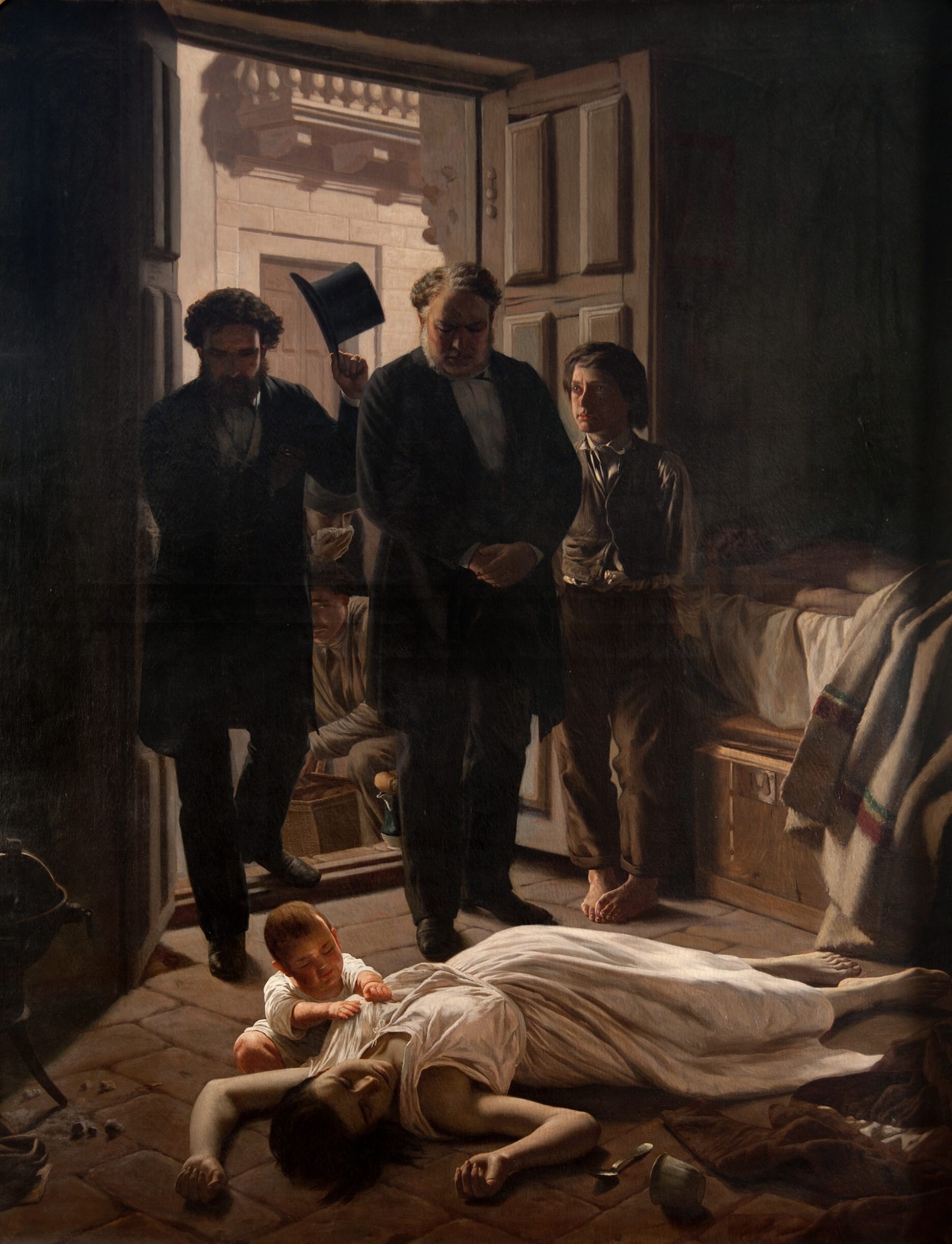El Ciclo/The Cycle
Gabriel González Núñez
A series of 8 (eight) poems, written in Spanish and self-translated in English.
Based on global, visual works from the National Gallery of Art (NGA) and reproduced as part of the public domain.
Made possible by a grant from the Center for Latter-day Saint Arts, Art for Uncertain Times.
An Episode of the Yellow Fever in Buenos Aires (1871), Juan Manuel Blanes. One of eight visual art works González Núñez responds to with his poetry.
I chose to write eight poems because the pandemic made me think of the menorah as a symbol of hope
Sobre el proceso creativo
La pandemia de covid-19 nos hizo cobrar consciencia de que, a pesar de nuestros avances técnicos, los seres humanos seguimos siendo vulnerables. Esto me llevó a reflexionar en que la historia, así como la vida, ocurre en ciclos: todo va bien, algo nos golpea, esto nos desespera y, finalmente, logramos reponernos y seguir. Esta idea inspiró la serie de ocho poemas titulados «El ciclo».
La pintura siempre me ha resultado inspiradora, y por lo tanto quise que los ocho poemas brotaran de obras de arte de pintores del mundo entero. En Cotopaxi, del estadounidense Frederic Edwin Church, vi ese momento idílico en que todo aparenta paz y bienestar. En Paisaje con la caída de Ícaro, del brabanzón Pieter Brueghel el Viejo, vi que cuando ocurre la catástrofe, la gente suele estar desapercibida. En Un episodio de la fiebre amarilla en Buenos Aires, del uruguayo Juan Manuel Blanes, vi el azote de las plagas. En La gran ola de Kanagawa, del japonés Katsushika Hokusai, vi que ante los caprichos de la naturaleza, de la vida, nuestros mayores esfuerzos son minúsculos. En El grito, del noruego Edvard Munch, vi que el peso de todo, de la vida misma, lleva a la desesperación. En Jesús mirando por una celosía, del francés James Tissot, vi que todo lo sufrido lleva a una sola pregunta: ¿acaso le importamos a Dios? En Patio interior de Strangade 30, del danés Vilhelm Hammershøi, vi la respuesta: la luz siempre prevalece. Finalmente, en La ronda, del uruguayo Carmelo de Arzadun, vi el renacer de la esperanza.
Opté por hacer ocho poemas porque la pandemia me hizo pensar en la menorá como símbolo de esperanza. Hay momentos en que todos necesitamos que el aceite arda milagrosamente durante ocho días mientras se purifica el templo.
***
About the creative process
The COVID-19 pandemic made us realize that, despite all our technological advances, as human beings we continue to be vulnerable. This made me reflect on history, which much like life, occurs in cycles: everything is fine, then something hits us, this makes us desperate, and finally we get better and move forward. This idea inspired the eight-poem series titled “The Cycle.”
Paintings have always been inspiring to me, so I wanted these eight poems to emerge from works of art by painters from the world over. In Cotopaxi, by American Frederic Edwin Church, I saw that idyllic moment when all has the appearance of peace and wellbeing. In Landscape with the Fall of Icarus, by Brabantian painter Pieter Bruegel the Elder, I saw that when catastrophe comes, people are usually oblivious. In An Episode of the Yellow Fever in Buenos Aires, by Uruguayan Juan Manuel Blanes, I saw the scourge of plague. In The Great Wave off Kanagawa, by Japanese printmaker Katsushika Hokusai, I saw that when faced with nature’s (or life’s) whims, our best effort are really quite insignificant. In The Scream, by Norwegian Edvard Munch, I saw that the weight of it all, of life itself, leads to desperation. In Jesus Looking through a Lattice, by French painter James Tissot, I saw that all the suffering leads to a single question: Does God even care? In Courtyard Interior at Strandgade 30, by Danish painter Vilhelm Hammershøi, I saw the answer: Light always prevails. Finally, in Dancing Around in a Circle, by Uruguayan Carmelo de Arzadun, I saw the rebirth of hope.
I chose to write eight poems because the pandemic made me think of the menorah as a symbol of hope. There are moments in which we need the oil to burn miraculously for eight days while the temple is cleansed.
Transferring these poems into English presented all the usual challenges of translating poetry. Poetry is created through form and content, and both cannot be fully preserved while translating. For this reason, some have said that poetry simply cannot be translated. I understand but, alas, do not agree. In truth, all translation is adaptation, and in translating these poems, this was quite evident. At times I prioritized form and at others content, all in an attempt at balancing the two.—Gabriel González Núñez, 2020
Gabriel González Núñez
is a professor at the University of Texas Rio Grande Valley where he trains translators and interpreters.
He earned his Ph.D. in Translation Studies at KU Leuven ('14), where he was a Marie Curie Actions fellow. He also has an M.A. in Translation and Intercultural Studies (Universitat Rovira i Virgili '11), a J.D. (Brigham Young University '07), and a B.A. in Spanish Translation (Brigham Young University '01).


